9 Best SLA Management Monitoring Tools for 2023 (Paid & Free)
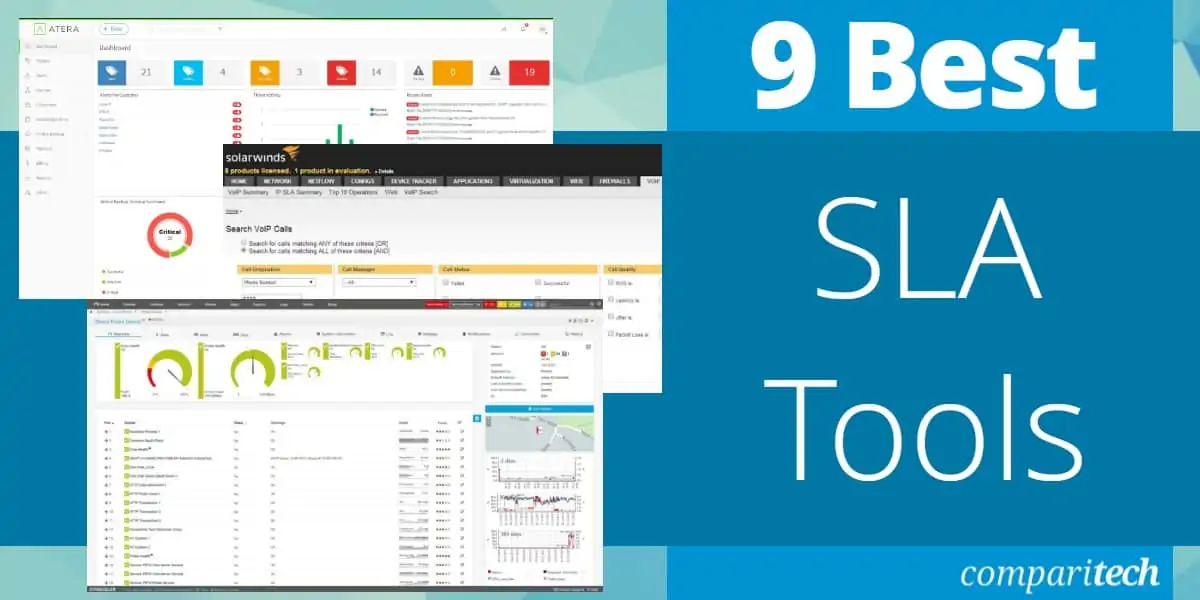
Staying on top of Service-level Agreements (SLA) is a matter of attention to detail. The provider needs to make sure that it meets the terms of the agreement, and users need to check that the service they paid for has been provided.
SLA Management and SLA Monitoring tools are critical for making sure that the terms of an agreement are fulfilled.
The list includes SLA monitoring tools, SLA management software, and help desk tools for Windows and Linux.
Mục lục bài viết
Here is our list of the nine best SLA Management & SLA Monitoring tools:
What is SLA Monitoring?
It is all very well having an agreement for the provision of a service but both sides need to monitor all of the conditions of the service during ongoing operations to make sure that the standards specified in the SLA are met. Although there might be mechanisms for failure to meet the standards laid out in the SLA, the client needs to constantly check that the required performance is attained because the provider possibly won’t keep an honest record.
Similarly, the service provider needs to keep a log of all activities that are covered by an SLA to ensure that those expectations are met. Examples of performance measures that would need to be tracked would be the maximum wait time for customer service attention per call, the lead time for software updates, and the frequency of system health checks. The exact actions that need to be measured depend on the conditions stipulated in the SLA.
Our methodology for selecting SLA management tools
We reviewed the market for SLA management systems and analyzed the options based on the following criteria:
- Contract requirements management
- VoIP QoS tracking
- Network performance monitoring
- Technician team management
- Task tracking
- A free trial or a demo system to assess the software without having to pay
- Value for money from a service that provides competent SLA tracking at a fair price
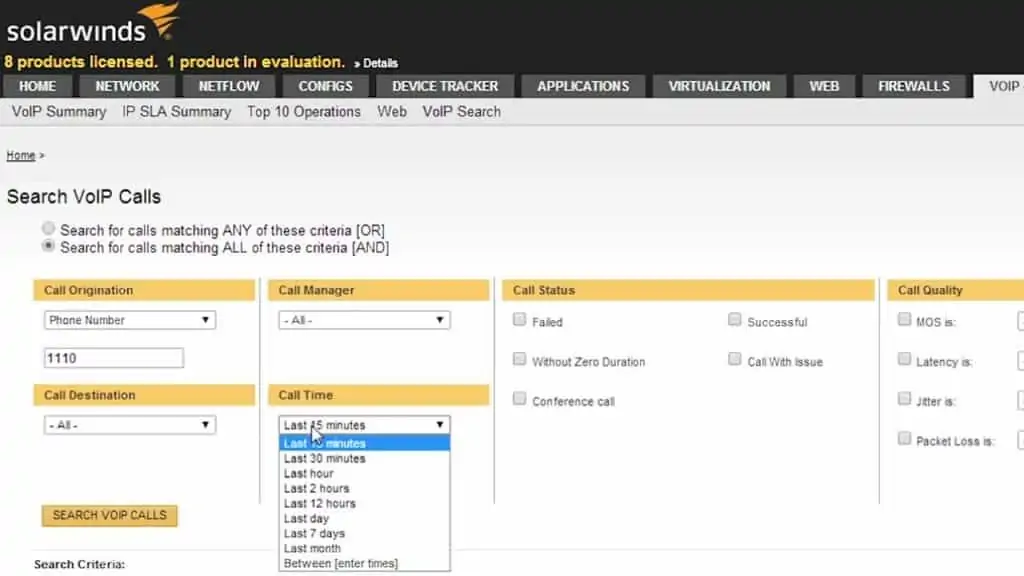
SolarWinds VoIP and Network Quality Manager is a QoS monitoring tool that supports IP SLA for Cisco routers and switches. You can automatically discover Cisco IP SLA-enabled devices and monitor their performance. The tool can also be used to monitor the performance of VoIP communications and monitor metrics such as jitter, latency, packet loss, and MOS.
Key Features:
- Real-time WAN monitoring with Cisco IP SLA
- Custom alert system
- Out-of-the-box IP SLA reports
- VoIP call path trace
Why do we recommend it?
SolarWinds VoIP & Network Quality Manager deals with a different kind of SLA – IP SLA, which looks at response times and regularity of packet delivery. This information can be tied to a contractual service level agreement, for example, interdepartmental expectations of service from MSPs or ISPs.
The user interface provides you with a high level of visibility over SLA performance. For example, you can use the Top 10 IP SLA dashboard to monitor the performance of your WAN environment. You can also view a performance map to see how performance changes throughout the network.
An alerts system makes sure that you don’t overlook any important information. Alerts can be customized so that you control when you receive notifications. You can also schedule default IP SLA reports keeping you updated on service changes.
Who is it recommended for?
This tool is meant for use to examine LAN performance but it can also track inter-site connection performance over the internet. It is also a good package for checking out leased line and SIP trunking services, which can form part of contract SLA enforcement. Communications-dependent businesses need this monitoring system.
Pros:
- Enterprise-focused solution for VoIP management, highly detailed
- Can easily monitor multiple sites and key quality metrics from a single customizable dashboard
- Features a network map that helps teams visualize VoIP issues, great for troubleshooting complex deployments
- Can automatically discover VoIP devices, making onboarding a simple process
- Supports detailed SLA monitoring measuring packet loss, jitter, MOS, and latency
Cons:
- The tool is specifically designed for enterprise use, fully exploring all features and options will take time
SolarWinds VoIP & Network Quality Manager is an SLA management tool that’s very easy to deploy and manage on Windows. Autodiscovery and a simple user interface make it ideal for fast deployment. Prices start at $1,746 (£1,420). You can download the 30-day free trial.
EDITOR’S CHOICE
SolarWinds VoIP & Network Quality Management is our top pick for SAL management monitoring because it ensures proper measurement of voice traffic delivery. This tool collects and stores a record of VoIP performance data that enables you to head off deteriorating quality before it becomes noticeable to users. The data from IP SLA statistics could also be used to prove compliance to contract service quality requirements. This tool also integrates with other SolarWinds network monitoring utilities.
Start 30-day Free Trial: solarwinds.com/voip-network-quality-manager/
OS: Windows Server
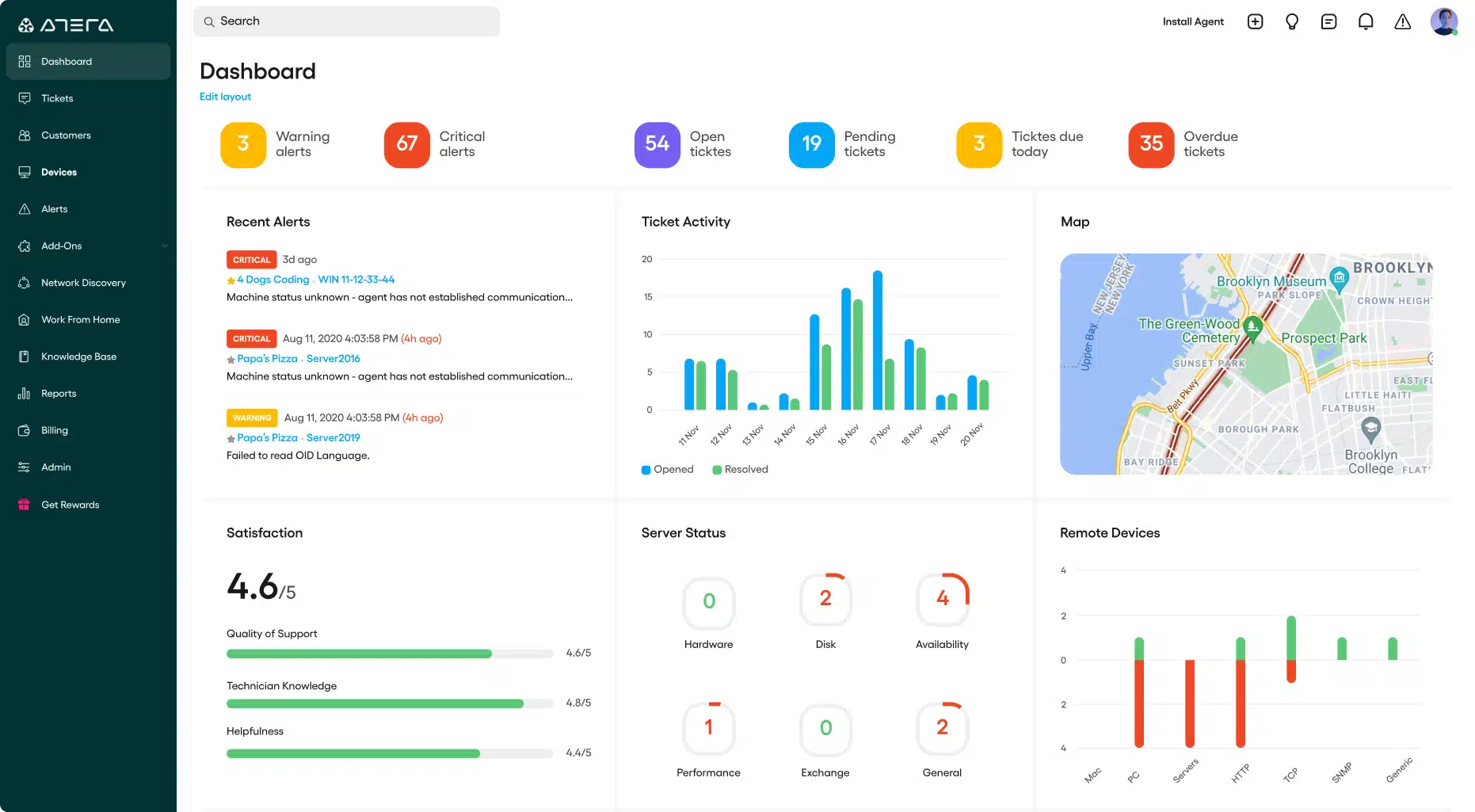
Atera is a cloud-based service that includes all of the software that a managed service provider (MSP) could need. This includes both the remote monitoring and management tools (RMM) used by technicians in day-to-day support operations and professional services automation systems (PSA) used by the management of the MSP.
Key Features:
- SLA manager for first response time and resolution agreements
- Easy to configure
- Automatic time capture for billing and time sheets
- Manage multiple contracts with different rates
Why do we recommend it?
Atera Flexible Contracts and Billing is a unit in the SaaS plans that are offered to managed service providers. The package provides templates for the creation of contracts and service-level agreements. Those SLAs are then plugged into activity tracking to set delivery timers and automated invoice generation.
The SLA screen of the Atera PSA lets you define different policy combinations, specifying require response times and open ticket durations. Each SLA template can then be applied to a contract. Should a new customer specify conditions that aren’t covered by one of your SLA policies, you just created a new SLA format to suit.
The PSA is linked to a ticketing system that tracks performance and schedules work for the support team with the SLA software settings taken into consideration in the algorithm. The system monitors performance and alerts management should any task approach a completion time threshold to avoid breaking the SLA. The manager can then reallocate the task to a different technician or add extra resources to the ticket.
Contracts and SLAs are stored in the Atera system and used when translating team timesheets into invoices. All of the storage needed for this data is included in the price of this cloud service.
Who is it recommended for?
Although Atera produces a package for use by IT departments. The contracts and SLA system is only available on the MSP version of the cloud platform. The system is produced in three plan levels plus the option for a custom package. The per-technician pricing makes this service scalable.
Pros:
- Minimalistic interface makes it easy to view the metrics that matter most
- Flexible pricing model makes it a viable option for smaller MSPs
- Includes multiple PSA features, great for helpdesk teams and growing MSPs
- Can track SLAs and includes a time-tracking option for maintenance tasks
Cons:
- Smaller networks will likely not be able to utilize the MSP-specific features found in Atera
Atera is charged per month per technician and there are no deposit requirements or minimum service periods, so it is very easy to add or remove seats as the requirements of the business demands. You can get a free trial of Atera.
Atera Flexible Contracts and Services
Start FREE Trial
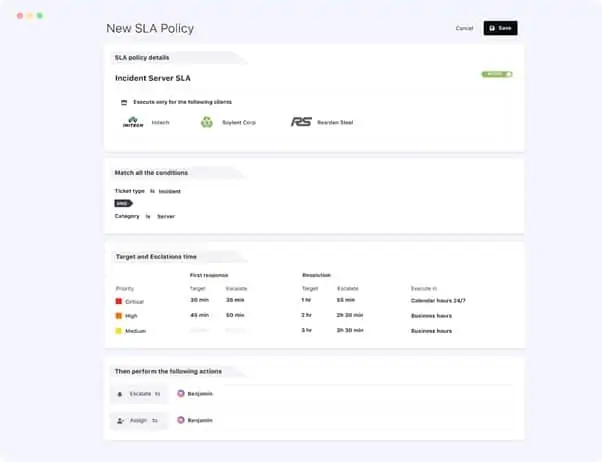
SuperOps SLA Management is part of a professional services automation (PSA) package that is delivered from the cloud and partners with a remote monitoring and management (RMM) system to provide all of the software needs of any managed service provider (MSP).
Key features:
- SLA creation and management
- Ticketing system
- Project and team management
- Data exchange between modules
Why do we recommend it?
SuperOps SLA Management is part of a cloud platform of MSP systems. Specifically, this is part of the PSA package on the platform. By setting up your service levels in this module, you get all goals and performance obligations tracked throughout the operations of the MSP.
The PSA includes a Service Desk system that manages technician teams and gathers performance metrics. This enables automated SLA goal tracking and will generate and file appropriate documentation to prove SLA achievements. The SLA goals are also fed through to the team management system so technician leaders can identify when tasks need to be prioritized and escalated to meet deadlines.
The system offers flexible routing options for tasks to ensure that SLA goals are met. The pricing structure for the entire SuperOps service makes it very easy to add on extra seats at times of need in order to staff up to keep within SLA parameters.
Who is it recommended for?
Naturally, this system is designed for managed service providers. PSA is professional services automation and it includes tools for running MSP businesses. The platform also offers a remote monitoring and management plan (RMM) and there are also combination packages. All plans are priced per technician, which makes them accessible for all business sizes.
Pros:
- A platform that includes the software and also storage space for logs and reports
- A closed-loop system that flows data automatically between Client Management and Service Desk modules.
- A contacts system that enables you to file all discussions with the clients over contracts and SLAs in one place
- Automatic performance tracking that feeds through to SLA compliance logging and billing
Cons:
- No native accounting function for invoicing – this is provided by a third-party paid add-on
SuperOps PSA and RMM are offered in four packages. The Solo plan is for independent freelance technicians and is free for the first year. The Starter edition is a PSA-only package. The Growth plan caters to smaller MSPs that don’t need a full Protect Management module and the Premium service includes all PSA and RMM modules. All plans are priced per technician. You can get a 21-day free trial of any of the editions.
SuperOps.ai SLA Management
Start 21-day FREE Trial
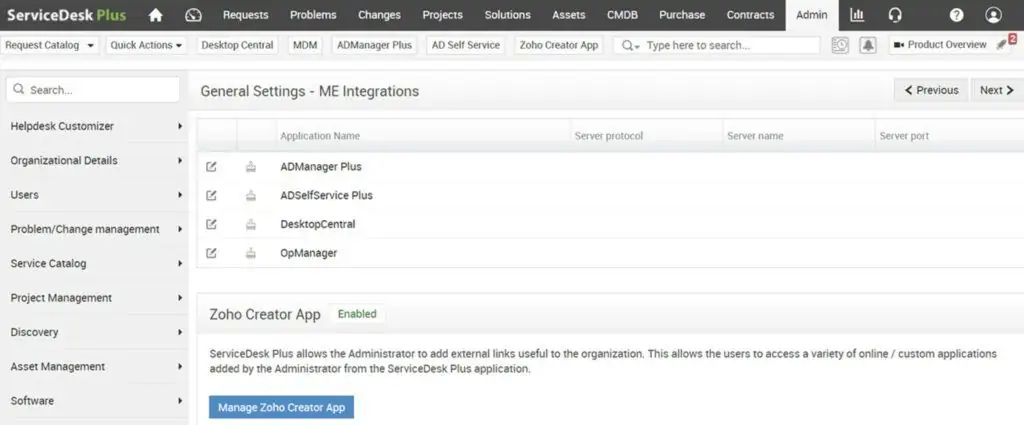
ManageEngine ServiceDesk Plus is an IT help desk tool that provides support for SLA management. With ManageEngine ServiceDesk Plus you can create site-specific SLAs for incidents and service requests.
Key features:
- Create SLAs
- Ticketing system
- Automatic escalations
- Available on-premises and in the cloud
Why do we recommend it?
ManageEngine ServiceDesk Plus is an IT asset management and Help Desk system. As such, it is a good product for use by managed service providers and the tool is also a good fit for IT departments. This package includes an SLA management module, which tracks task resolution progress according to SLA deadlines.
As a help desk tool, the focus is on helping the user to respond to issues quickly. The user interface helps you respond faster by allowing you to configure response times to encourage a speedy response to performance issues.
Managing multiple SLAs is simple because they’re automatically assigned based on priority, enabling employees to respond to the most pressing issues first. Automated escalations ensure that tickets get dealt with promptly. You can also assign tickets to groups. Having all of this information in one location makes it much easier to avoid falling foul of any active SLAs.
Who is it recommended for?
This tool is aimed at IT departments that provide services as a cost center to other business departments. ManageEngine offers this system free forever for five technician seats. There are three editions, which cater to organizations of different sizes and all are available as a SaaS package or for installation on Windows Server or Linux.
Pros:
- Robust all-in-one tool for managing client contracts, maintenance requests, and other ancillary services MSPs normally offer
- Automatic asset discovery helps keep NOC teams informed of the scope and new devices that are added to the network
- Cross-platform support work with Windows or Linux server distros
- Available for on-premise deployment as well as a SaaS
Cons:
- ManageEngine offers a range of services and products that can take time to fully explore and utilize
ManageEngine ServiceDesk is worth examining if you’re looking for a tool with ticketing and SLA software management capabilities. The software is available for Windows and Linux, on-premises or in the cloud. You must contact the company directly to request a quote. You can download the 30-day free trial.
ManageEngine ServiceDesk Plus
Start 30-day FREE Trial
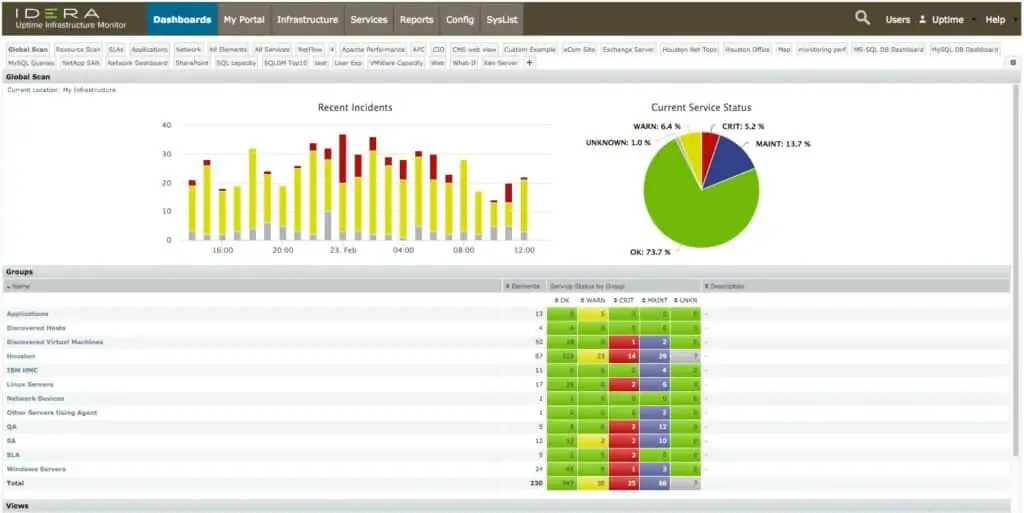
Idera Uptime Infrastructure Monitor is a network monitoring software that comes with an SLA Manager. You can monitor SLAs in real-time through the dashboard. The dashboard can be customized by drag-and-drop, with unique views for you and your entire team.
Key features:
- Real-time SLA monitoring
- Customizable dashboard
- SLA reports
- SLA testing
Why do we recommend it?
Idera Uptime Infrastructure Monitor is an on-premises package that tracks the availability of Web assets. This service can be used to track service delivery by internet service providers and Web hosting systems. The package includes an SLA tracker that will generate alerts when systems are uncontactable.
One of its unique features is SLA testing. You can draw up an SLA target and then use your historical performance data to test whether you can meet the requirements of the proposed SLA. Running tests in advance reduce the chance of you failing to deliver on an SLA.
The SLA reporting feature allows you to set Service Level Objectives and monitor the delivery of those aims. Creating reports is invaluable for making sure that you stay on top of your SLA obligations. The tool also generates notifications about performance incidents. The root-cause analysis allows you to dive into the cause of the issue and resolve it to reduce the chance of any violations.
Who is it recommended for?
This software package runs on Windows and Linux. The system can be used to check on a company’s own obligations to other companies and internal clients. It is able to check on the availability of resources for physical and virtual systems and also cloud platforms. The tool includes a service level predictor.
Pros:
- Drag-and-drop dashboards allow for customized NOC views
- SLAs can be supplied on a team or individual basis
- Service-level objects can be used to make dynamic SLAs for different clients, applications, or services
- Installation is simple and straightforward
Cons:
- The interface can be clunky and lag at times
Idera Uptime Infrastructure Monitor is a reliable tool for midsize companies looking for a network monitor and SLA management solution. You must request pricing information from the company directly. The platform is available for Windows and Linux. You can start the 30-day free trial.
Idera Uptime Infrastructure Monitor
Idera Uptime Infrastructure Monitor
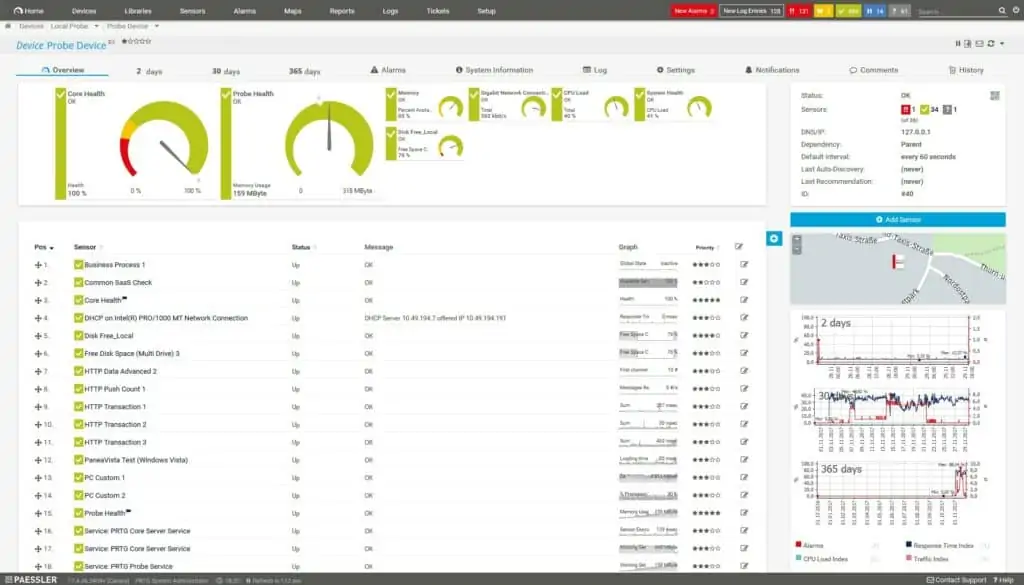
Paessler PRTG Network Monitor is a network monitoring tool that supports SLA monitoring. You can use sensors to monitor a network’s quality of service (QoS).
Key features:
- Autodiscovery
- Cisco IP SLA monitoring
- VoIP monitoring
- Integration with CORP IT
- Threshold-based alerts
Why do we recommend it?
Paessler PRTG Network Monitoring addresses SLAs in the same context as the SolarWinds package on this list. That is, the system tracks IP SLA for VoIP connection quality rather than contract conditions. However, the quality of voice lines can be subject to contractual expectations and so the PRTG system can help with that.
The platform has sensors for monitoring VoIP connections and Cisco IP SLA monitoring. Sensors can monitor a range of parameters. For example, the Cisco IP SLA sensor can monitor Calculated Planning Impairment Factor (ICPIF), Mean Opinion Score (MOS), late packets, average VoIP jitter, network latency, and more.
Integration with CORP IT provides the user with plugins to manage SLA software. The platform provides a PRTG SLA plugin, which allows you to export monitoring data to SQL Server Reporting Engine and Crystal Reports.
A threshold-based alerts system gives you complete control over when alerts are triggered. Set alert trigger conditions and receive notifications by email, SMS, push notifications, Slack messages, syslog messages, SNMP traps, and more. You can even run PowerShell scripts remotely.
Paessler PRTG Network Monitor is packaged with a Cisco IP SLA sensor that is able to monitor a host of parameters including ICPIF for packet loss, MOS for jitter, round trip latency and more. By using PRTG as IP SLA monitoring software you can bypass extra add-ons and unnecessary additional costs.
Who is it recommended for?
PRTG is useful as a network monitoring system rather than as a contract management package. This tool will run on Windows Server but you can also access it as a SaaS package. The system if free to use if you only activate 100 of its sensors.
Pros:
- Uses a combination of packet sniffing, WMI, and SNMP to report network performance data
- Fully customizable dashboard great for NOC teams
- Drag and drop editor makes it easy to build custom views and reports
- Supports a wide range of alert mediums such as SMS, email, and third-party integrations into platforms like Slack
- Each sensor is specifically designed to monitor each application with it’s own SLA metrics
- Supports a freeware version
Cons:
- Is a very comprehensive platform with many features and moving parts that require time to learn
Paessler PRTG Network Monitor is a high-quality network monitoring tool that’s recommended to organizations that want a free SLA management solution for Windows. The free version supports up to 100 sensors. If you require more, you can purchase a paid version, which starts at $1,750 (£1,422.51). You can download the 30-day free trial.
Paessler PRTG Network Monitor
Download 30-day FREE Trial
Related: Cisco Network Monitoring
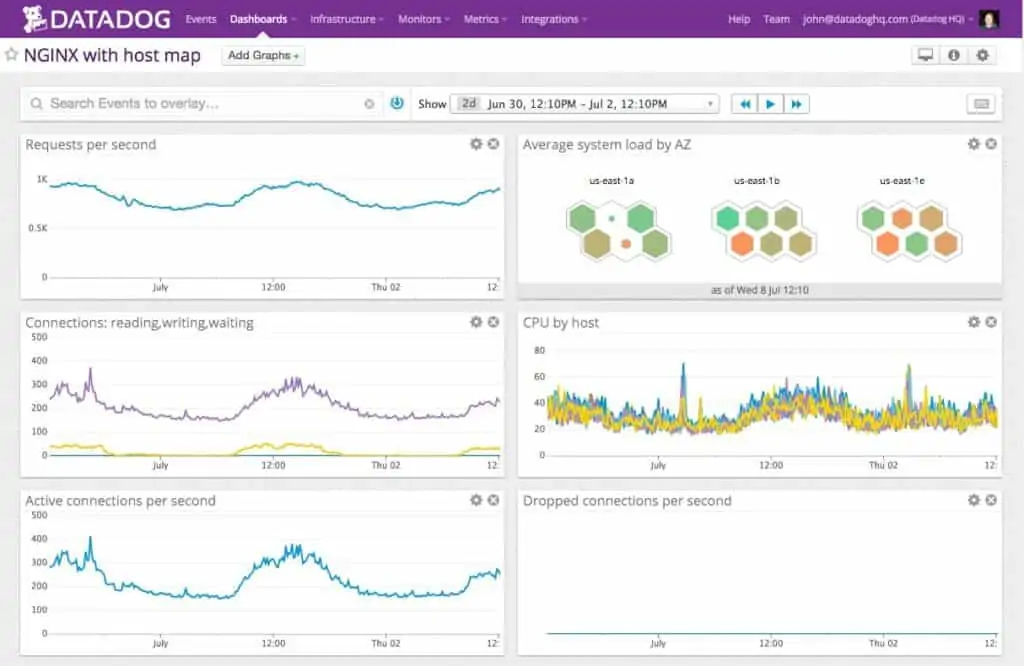
Datadog is a cloud and SLA monitoring tool. It provides real-time SLA monitoring for metrics including availability, response time, throughput, error rates, and more through a customizable dashboard. The dashboard can be edited with a drag-and-drop user interface and shared with other members of your team.
Key features:
- Real-time SLA monitoring
- Custom dashboard
- Test sites with API tests
- Integrations with Slack, Pagerduty, and Jira
Why do we recommend it?
Datadog implements SLA monitoring as network consistency with IP SLA measurements. This is implemented by the Network Performance Monitor. If you get Web hosting, you can use the Synthetic Monitoring module to check on your website’s availability and report downtime in the context of the SLA that you have with your hosting package.
You can use the platform to monitor the uptime of your sites. Datadog can run API tests that will launch HTTP requests from different locations to measure performance. Information you can view includes latency and error rates with a range of graphs and charts for greater clarity.
The program also provides you with over 15 months of historical data so that you can create accurate service-level agreements. Likewise, Datadog also has the capacity to forecast performance issues so that you can take preventative action before end-users are affected. When there is a problem, alerts let you know immediately.
Who is it recommended for?
Using the Network Performance Monitor is a little complicated because it requires that you also have a subscription to the Infrastructure module. You get network mapping with the Network Performance Monitor but you need to subscribe to the Network Device Monitoring package to get autodiscovery. The Synthetic Monitoring module can operate by itself.
Pros:
- Operates in the cloud, making scaling your troubleshooting efforts easier than most on-premise solutions
- Offers excellent visual reporting that are fully customizable
- Agent software can be installed on multiple operating systems as well as in the cloud to monitor container-based services
- SLA metrics are provided out-of-box, but can also be customized to your liking
- Pricing options are flexible, making Datadog a good choice for both small and large size networks
Cons:
- Would like to see a longer 30-day trial period
The Datadog agent is available for CentOS, Debian, Fedora, Red Hat, SUSE, Ubuntu, and Amazon Linux. The software is available for free and supports up to five hosts with one-day metric retention. The API tests version of Datadog supports uptime monitoring for SLAs and SLOs for a price of $5 per ten thousand test runs, per month. You can get started with a 14-day free trial.
Datadog Simplified SLA Monitoring
Start 14-day FREE Trial
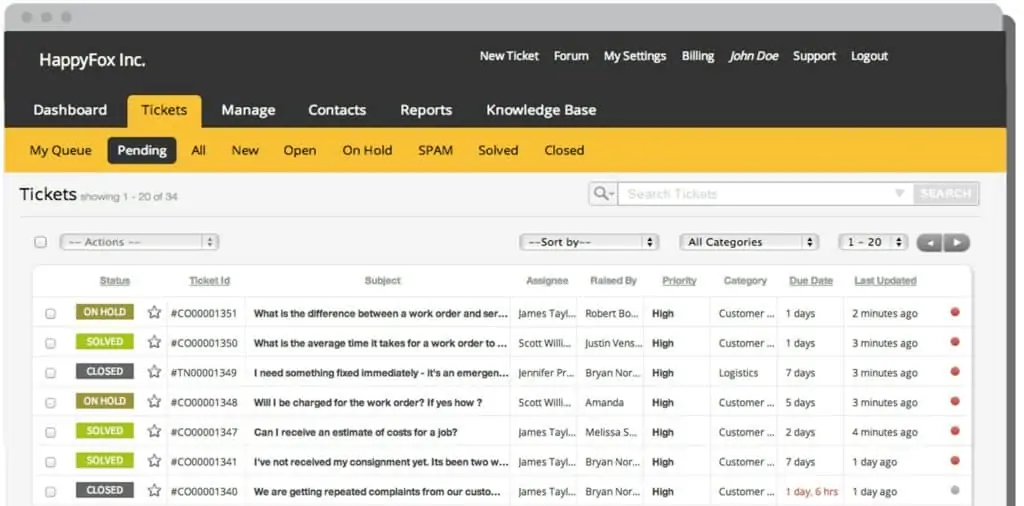
Happyfox Help Desk is a web-based help desk software that provides SLA management features for enterprises. It allows you to create and monitor SLAs. The monitoring experience functions off of a four-part-system where you set an objective, a set of conditions, a goal percentage, and a work schedule.
Key features:
- Dashboard
- SLA reports
- Rest API
- Email and live chat support
Why do we recommend it?
Happyfox Help Desk is a cloud-based ticketing system that channels user requests to a team of technicians. The system enables an administrator to enter SLA rules that will time the resolution for each problem. This isn’t an automated SLA or contracts management service like that in the Atera PSA.
For example, you can set an objective for the time taken to send the first response to users to be less than 30 minutes, and then set a condition to notify you if this parameter is breached.
The software also lets you configure time to first response, time to assign the ticket, time to contact response, time to staff response, and time to conclude. Monitoring all of these timeframes helps you to measure how efficient your service is across the board so you can make targeted improvements.
Create SLA reports to monitor SLA performance and assess the effectiveness of your response. Reports can show the number of tickets checked, tickets breached, alongside the target percentage and achieved percentage. These reports can be exported in CSV and Excel to share with other employees.
Who is it recommended for?
Happyfox Help Desk is a good solution for businesses that don’t need a full PSA. For example, internal support teams don’t need a contracts management feature but they do need a ticketing system that can ensure delivery quality obligation. This is also useful for customer service.
Pros:
- Web-based dashboard makes SLA monitoring easier for remote users
- SLAs are defined by four conditions, allowing you to easily establish a detailed overview for alerts can expectations
- Built specifically for MSPs and multi-tenant use
Cons:
- The interface menus can be cluttered at times
- Would like to see less false positive on SLA alerts for ticketing
- Integrations into email and other applications can be cumbersome
Happyfox Help Desk is recommended for users who want an SLA management solution with help desk capabilities designed to speed up resolution times. Pricing starts at $29 (£23.56) per agent per month. You can request a demo.
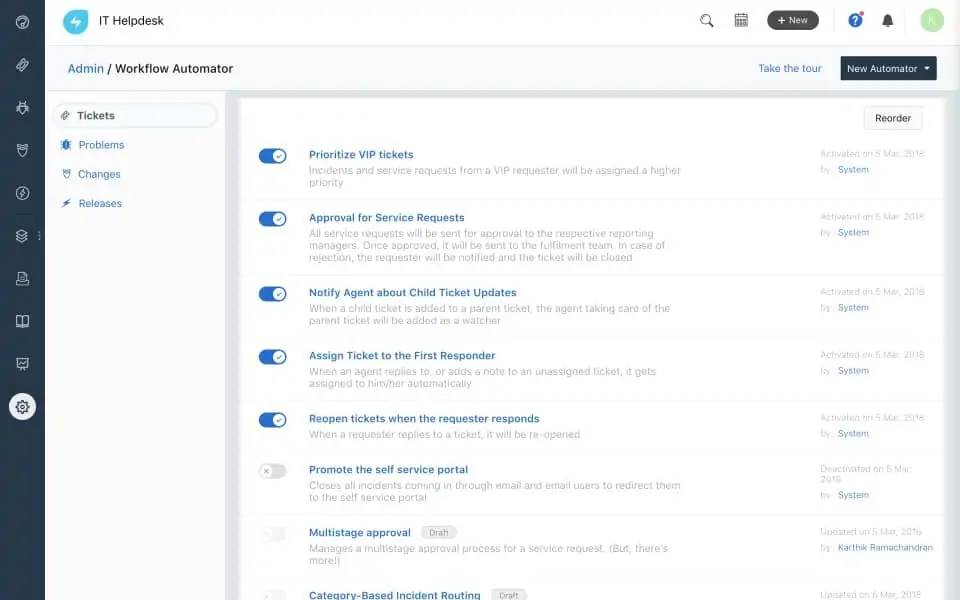
Freshworks Freshservice is a web-based IT service desk tool with SLA management. With Freshworks Freshservice you can set SLA targets through a dashboard. You can configure targets by priority, response time, and resolution time. Larger enterprises with multiple sites can set different service level targets according to location.
Key features:
- Set SLA targets
- Alerts
- Ticket escalation
Why do we recommend it?
Freshworks Freshservice is one of the most widely used online IT asset management and help desk systems on the market. This is a very comprehensive package that offers a lot more than just a help desk ticketing system – Freshworks offers Freshdesk for that. This tool also manages projects for system development.
You can also set the operational hours so that employees only receive alerts if they’re in the office. The escalation email checkbox allows you to receive notifications when there is an issue. Alerts enable your team to respond to customer concerns efficiently and keep the time to resolution low.
If there is a violation, then Freshworks Freshservice can automatically issue notifications and escalate according to rules you have defined. For example, you can set tickets to automatically escalate if they haven’t been responded to or resolved in four hours.
Who is it recommended for?
There are four plans for Freshservice. All four are suitable for use by DevOps teams for internal IT management and the upper three also have an MSP mode for managed service providers. Pricing is per agent and there are many add-on modules, so this is a very flexible package.
Pros:
- One of the better user interfaces for ITSM tools
- Flexible subscription and annual pricing options
- Includes a self-service portal to help reduce inbound tickets
- Simple ticket creation is user friendly for new staff
Cons:
- The trial could be a bit longer
- Automation workflow between tickets could be better
- Integrations into other ITSM tools can be complicated
Freshworks Freshservice is a reliable SLA management solution that’s ideal for global enterprises managing multiple teams. There is an app available for iOS and Android. Prices start at $19 (£15.44) per agent per month with support for unlimited end-users. You can start the free trial.
Choosing an SLA management monitoring Tool
SLAs are essential for making sure that providers deliver the exact service that customers have paid for. SLA management tools enable companies to make sure that they maintain the obligations listed in any agreements. Customers and providers alike can monitor services to make sure the conditions of the agreements are fulfilled.
Our editor’s choice for this article is Paessler PRTG Network Monitor for IP SLA and QoS monitoring and Happyfox Help Desk for general SLA management and help desk capabilities. Depending on your needs you can look at tools designed with network monitoring in mind or those that prioritize a ticketing system for managing performance concerns.
SLA Management FAQs
What is SLA management?
SLA management is an ongoing process for the duration of a contract. It measures the service provider’s performance, recording whether or not the expected frequency, deadline, or quality of service delivery is always met.
What are the 3 types of SLA?
According to ITIL, there are three types of SLA structures:
Service-based
Customer-based
Multi-level or Hierarchical
Related post: VoIP Monitoring Tools











